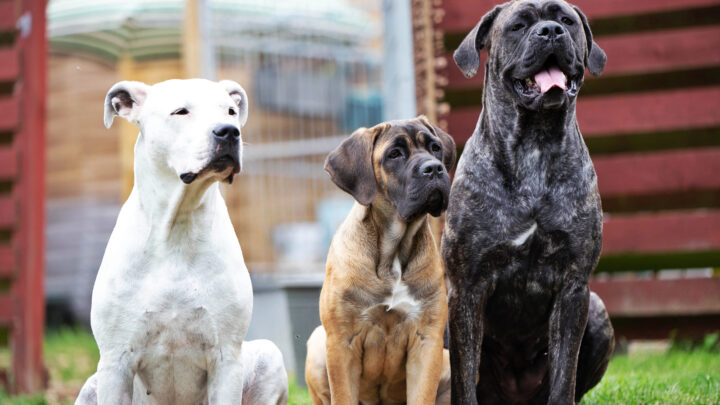
Are large, powerful dogs your thing? If giant dogs are your thing, then breeds like the Great Dane, Pitbull, German Shepherd, and Rottweiler are probably already household names to you.
What about comparing the Cane Corso to the Dogo Argentino? Everyone who passes the dog park seems to double back for a second look at these two breeds.
Some people could even mistake one for the other, but those who are acquainted with the two breeds will always be able to tell the difference between a Dogo Argentino and a Cane Corso just by looking at their coat color.
What distinguishes these two enormous dog breeds from one another, except the obvious fur color contrast? And who would come out on top if they squared off? Which one is more suitable as a household pet?
Keep reading if you’re curious in the Dogo Argentino vs. Cane Corso contrasts and similarities.
Difference Between Cane Corso And Dogo Argentino
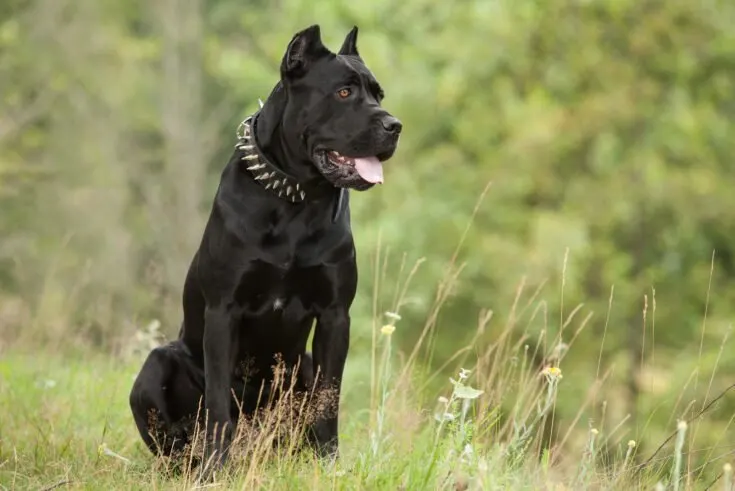
When comparing the Dogo Argentino with the Cane Corso, it’s important to look under the surface to discover the various distinctions between the two breeds.
See a short comparison in the table below before we dive into more depth:
| Cane Corso | Dogo Argentino | |
|---|---|---|
| Height: | 23.5–27.5 in | 24–27 in |
| Weight: | 90–120 lb | 88–100 lb |
| Lifespan: | 10–12 years | 9–15 year |
| Coat color: | black, fawn, brindle, grey, red | white |
| Temperament: | calm, trainable, quiet, reserved | friendly, loyal, protective, affectionate |
Dogo Argentino Vs. Cane Corso Origins
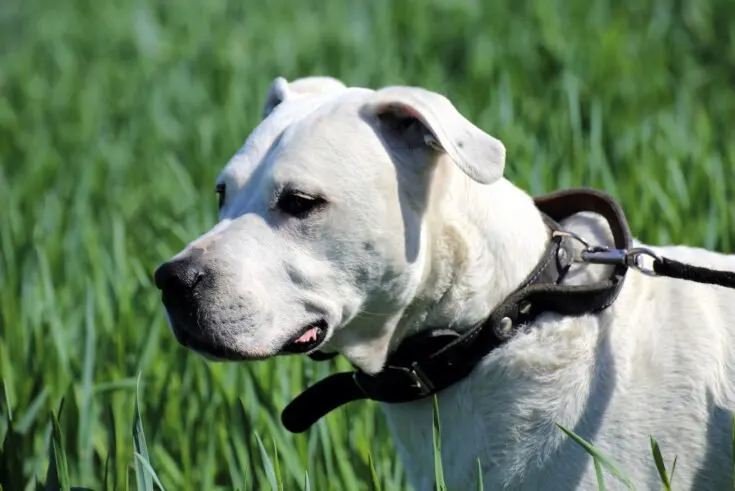
These puppies may appear same, but they come from quite diverse backgrounds. They had traveled from opposite ends of the globe for very different reasons.
A dog’s past has a considerably bigger impact on its personality and looks than most people realize. This is due to the fact that humans have manipulated canine breeds to serve certain functions, which has had a knock-on effect on the dogs’ personalities.
The comparison of the Dogo Argentino and the Cane Corso requires knowledge of the ancestry and history of both breeds.
So here’s the backstory on them:
Dogo Argentino
The Dogo Argentino, as its name implies, is a native of Argentina.
This is a new variety. The Old Fighting Dog of Cordoba was purposely bred with many other big dog breeds (mainly Mastiff-type canines) including the Boxer, the Bulldog, the Great Dane, and the Bull Terrier.
One may then have the ideal canine combatant. Therefore, the earliest the breed might have existed was the early 20th century. Specifically, the Argentine Kennel Club officially acknowledged it for the first time in 1964. Not until early 2020 did the AKC officially acknowledge it.
Cane Corso
Unlike the Dogo Argentino, the Cane Corso has classified as an old dog breed thanks to its membership in the Mollosus type.
They were first domesticated in Italy, although its ancestry may be traced back to ancient Greece and Rome. Therefore, they are frequently referred to as Italian Mastiffs since they are one of the few original Italian breeds.
The Romans used them as battle dogs, and after the end of hostilities, their primary purpose was to hunt boar, but they also served as guard dogs and farm dogs.
As more and more people migrated to urban areas, the Cane Corso dog almost became extinct in the middle of the twentieth century. It wasn’t until the 1970s that Cane Corso lovers rallied to get the breed officially recognized again.
When the Society Amorati Cane Corso (Society of Cane Corso Lovers) was established, the breed’s fortunes began to turn around.
But they didn’t become commonplace until the late 20th century and the early 2000s in the United States.
Dogo Argentino Vs. Cane Corso Coat Color
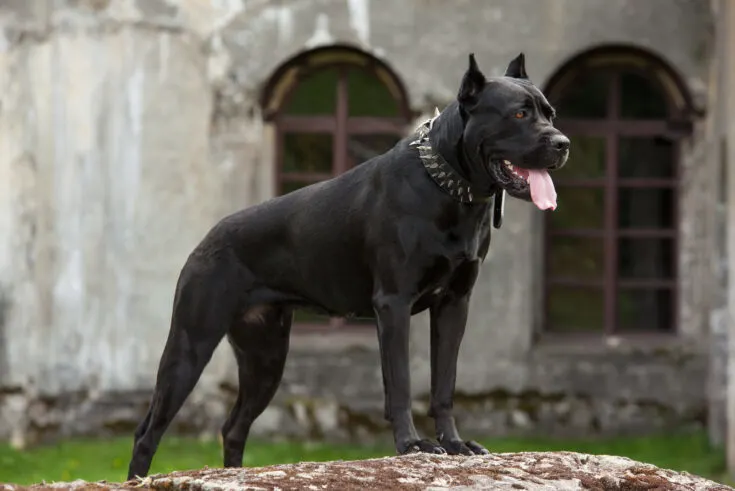
Dogo Argentinos and Cane Corsos are easily distinguished from one another by their distinctive coat colors. Due to their superficial similarities, it’s helpful that there is this one distinguishing characteristic between the breeds.
The white coat is a telltale sign that a dog is a Dogo Argentino. The best dogs of this breed have snowy white coats, although a few black patches here and there are quite good. However, white must serve as the primary hue.
On the other hand, Cane Corso dogs have a lot more personality and flair. Cane Corsos often come in black, but they may also be found in a number of different colors. Fawn, grey, black and chestnut brindle, and red are just a few of the recognizable hues. Many of them might even have two different colors.
Each dog has a short coat that is simple to clean and care for but offers little insulation from the elements. Although they may survive in colder climes, they prefer ones that are warmer.
Dogo Argentino Vs. Cane Corso Size
Both the Dogo Argentino and the Cane Corso are large, muscular canines. Both are massive canines, easily ranking among the largest in the canine species.
Cane Corsos have the potential to reach a height of 23.5–26 inches for females and 25–27.5 inches for males, making them only a little higher than Dogo Argentinos, who have the potential to reach a height of 24–25.5 inches for females and 24–25.5 inches for males.
Similar considerations apply to size; although Cane Corsos can reach 120 pounds or more, the Dogo Argentino typically tops out at about 100 pounds at most.
Comparison of the Life Expectancy of the Cane Corso with the Dogo Argentino
It’s common knowledge that big dogs don’t live very long. As a matter of fact, many huge canines have a rather low life expectancy.
Several factors contribute to this, but genetics appears to play the most role. Puppies of larger breeds grow and develop more rapidly than those of smaller varieties.
The danger of developing cancer is correlated with fast cell proliferation, which is unfortunate. Additionally, many orthopedic problems are linked to rapid skeletal development and increased body mass, and when these problems become serious enough, many dog owners choose to euthanize their dogs rather than treat them.
Among dogs of their size, the lifespans of the Dogo Argentino and the Cane Corso are among the best. We will discuss some of the most prevalent health problems that might shorten their life expectancy:
Cane Corso Lifespan
A Cane Corso’s robust health makes them an ideal family pet. This is mostly due to the fact that they have been there for ages rather than being the product of a hasty human creation.
However, there are a few illnesses you should watch out for. Diseases including demodectic mange, trachoma, and hip dysplasia are included in this category.
Still, bloat, or stomach torsion, is the greatest health concern for Cane Corsos. If left untreated, your dog will die within hours from this serious illness. Choosing high-quality dog food is one way to lessen the likelihood of this happening.
This is why it’s important to get your Cane Corso from a reliable breeder that does health checks on their dogs. On average, a healthy dog will live between 10 and 12 years.
Dogo Argentino Lifespan
Dogs of the Dogo Argentino breed tend to outlive their Cane Corso counterparts by around two years. Yet, they still have a high risk of bloat, the leading cause of mortality in adult dogs.
The Dogo Argentino may also be predisposed to autoimmune thyroiditis, hip dysplasia, and a host of other orthopedic problems.
Dogo Argentinos, on the other hand, are predisposed to a slew of illnesses that manifest themselves in their mostly white coats. Diseases of the eyes and ears, as well as an allergy predisposition, fall under this category.
In the hands of a trustworthy breeder, a Dogo Argentino may live for up to 15 years.
Cane Corso Vs. Dogo Argentino Temperament
There is not much of a difference between the dogs in terms of disposition. If you look at their background, you won’t be surprised to learn that both make excellent watchdogs and personal protection dogs.
At the same time, however, there are a few things to keep in mind.
While Cane Corsos were developed specifically for use in battle, Dogo Argentinos were initially bred for use in ring combat. Both puppies need to be properly socialized to reduce the risk of aggression against strangers. Also, they have an unwavering commitment to their masters.
Both types are loyal, kind, and affectionate pets that thrive with children if given the proper early socialization. You’ll need some experience with huge dogs, however, to get the most out of this breed.
Does the Cano Corso Get Along with Other Pets?
The Cane Corso’s placid and loving nature extends to its interactions with kids. However, this calls very early on in life socializing and obedience training.
But although they have a lot of pent-up energy that has to be channeled, their demeanor at home is often tranquil and they don’t put in much effort in the way of daily chores.
Cane Corsos may be wonderful family pets if they are raised in an environment where they are taught to trust and where their owners do not treat them with fear. However, owners must maintain a rigorous and consistent approach to training their dogs to ensure obedience.
They get along wonderfully with other animals and may be wonderful family companions if raised with one. They are alert to dangerous circumstances but usually wait for some kind of provocation before taking action.
Is it True that Cane Corso Dogs are Dangerous?
Cane Corso dogs have a reputation for being particularly hostile to strangers because of their breed’s violent past. They’re the kind of guard dogs who won’t stand by while their owners are hurt.
This, in addition to their massive size, is what makes prolonged social interaction with others so crucial for them. They have to be aware of what is and is not acceptable behavior. They’re a little too headstrong and need to know their place.
Cane Corsos are large, dangerous dogs that should never be left alone, since they may inflict major injury with their bites if they aren’t properly socialized.
A well-tempered Cane Corso, on the other hand, should be uninterested in people and able to deal with a lot of stress since his ancestors were working dogs.
A Cane Corso has a defect in his behavior if he loses his composure under pressure. No respectable breeder would ever offer you a dog descended from such a line.
Does the Dogo Argentino Get Along With Other Pets?
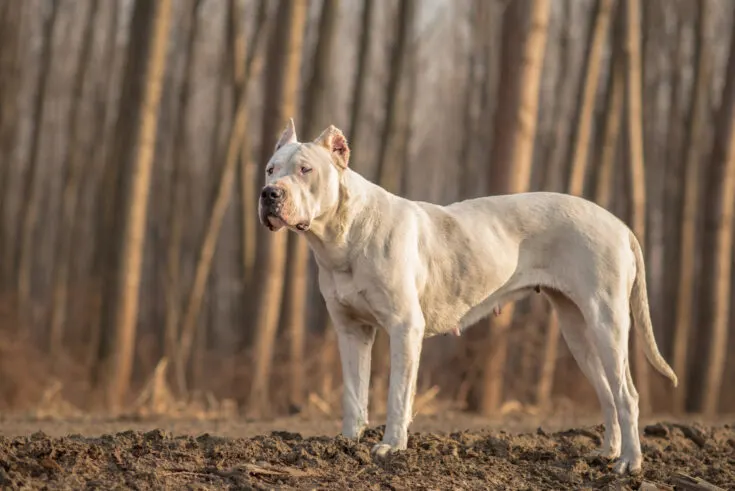
Dogo Argentinos are more reserved but sociable than their Cane Corso counterparts. These puppies are full of life and may become wonderful additions to any household with the right training.
In general, Dogo Argentinos get along well with kids if they’re raised with them from puppyhood. However, since they are powerful canines, they should never be left alone with children.
You should start early with socialization since they might be guarded and wary of strangers.
Due to their intense hunting drive and territorial temperament, they may also be aggressive against other dogs and even smaller pets. They need socialization with other pets from a young age since they were raised to be combat dogs.
Who makes the better watchdog, and why?
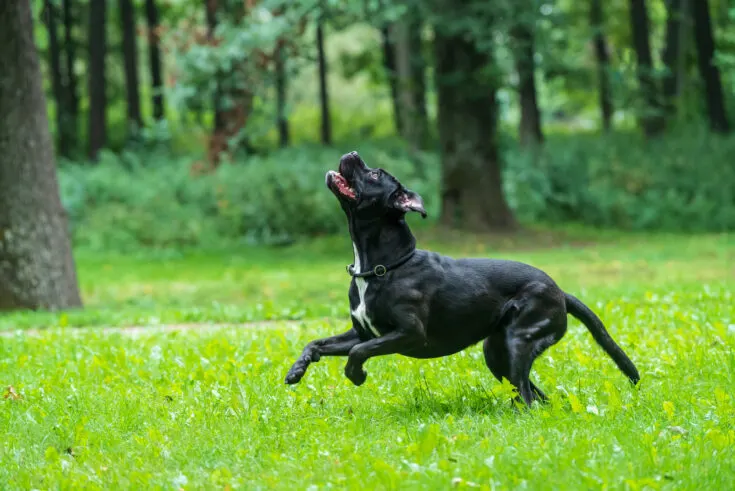
There are a few things that go into making a dog a reliable security dog. A dog has to be self-sufficient and possess the instinct to defend its home and family when necessary. Likewise, a good guard dog won’t want to be best friends with everyone who unexpectedly enters your property, therefore the puppy shouldn’t be too affectionate.
Both the Dogo Argentino and the Cane Corso meet these requirements. But there are two other factors that must be considered: intellect and trainability.
To learn orders quickly and effectively, a guard dog has to be both smart and obedient. A dog’s independent and tenacious nature, coupled with its intellect, might lead it to insist on doing things its own way.
Cane Corsos and Dogo Argentinos are equally competent in this regard. They are bright canines with a great desire to please their people. That’s why seasoned, firm entrepreneurs make the most difference.
Cane Corso may be more docile and sensitive, yet both breeds are responsive to good reinforcement. Although this makes them more amenable to being trained, it also requires extreme caution, since screaming at them might cause them to withdraw from the process.
Regardless, both types are large and powerful enough to discourage an attacker from breaking into your house without your knowledge or permission, making them ideal security dogs. Just make sure they don’t become bored, which may lead to behavioral problems, by providing them with adequate cerebral stimulation.
Are there any differences in how powerful they are?
Because of their massive size and sturdy frame, both dog breeds are very powerful. They were even sometimes used as hunting hounds, tasked with tracking down prey like mountain lions and boars. Just this fact alone ought to give you some idea of their power.
But if you want the best possible dog, you should think about qualities like agility, speed, and biting power.
Cane Corso seems to be the superior choice of the first two. This breed of dog was developed to be very nimble so that it could serve in a variety of roles, including hunting and combat.
Some Cane Corsos, in fact, may reach speeds of up to 32 miles per hour while running. In comparison, the Dogo Argentino, a breed that is not expected to be able to run faster than 25 miles per hour, would need almost three times as long to do the same thing.
However, both types of dogs are capable of making leaps of up to 6 feet in the air.
How Much Bite Force Does A Cane Corso Have?
One of the dogs with the strongest bite is the Cane Corso. As a matter of fact, only the Kangal can compare to it.
It is said that the bite of this particular dog breed is as powerful as a lion’s. In comparison to a lion’s ‘just’ 650 psi, its maximum biting force is 700 psi.
The Cane Corso’s biting power is the third highest among all breeds of dog.
In terms of bite force, how powerful is a Dogo Argentino’s jaw?
The Dogo Argentino is a breed of dog known for its formidable bite. Its bite is so powerful that it is believed to be approximately 500 psi.
Although it’s not a good idea to try this out on yourself, 500 psi is far less powerful than the 700 psi possessed by Cane Corso canines. Over 500 psi is more than enough to do serious damage.
To provide some perspective, the pressure of a human bite ranges from 120 to 160 psi.
Who Wins?
Since these two Mastiff types are sometimes mistaken for one another, many people are curious in the differences and similarities between the Dogo Argentino and the Cane Corso.
Now that the distinctions have been made clear, what may be the final verdict?
It’s conditional on your specific needs and goals.
You can’t go wrong with any of these breeds if you want a dependable security dog. Both are devoted to their owners and distrustful of outsiders, which makes them excellent alarm systems in the event of an attack.
While both are a little obstinate, they are smart and can be trained to know when to bark and when to ignore strangers.
The Cane Corso is somewhat larger than the other breeds, hence it wins the size comparison. Dogs of both types are massive in stature and have powerful builds that make them instantly recognizable to anybody.
While both breeds are powerful enough to easily take down a person, the biting force of a Cane Corso dog is 700 psi. They are so powerful that they would likely prevail in a battle against not only a Doberman or Rottweiler, but even a lion!
Since an aggressive Cane Corso would be the worst possible dog, it’s a good thing that the somewhat less powerful Dogo Argentino is seen as more aggressive.
Both breeds may make effective service dogs with the right training, although Cane Corsos tend to be more adaptable and calm than other dogs.
Hiking with them is a terrific idea since they have a lot of energy and need to get some exercise. These canines are full of energy and would enjoy training with you.
However, if you’re in the market for a family dog, bear in mind that these pooches aren’t for everyone. Taking care of and training a huge dog is a big responsibility that should only be taken on by those who have done it before.
Finally, it doesn’t matter whether you get a Dogo Argentino or a Cane Corso. Both may be wonderful lifelong companions with the right care and a skilled breeder.